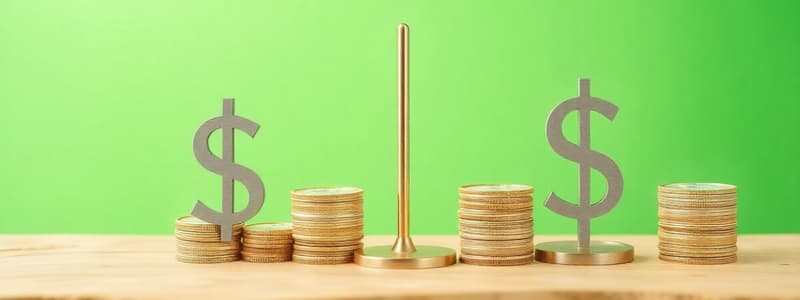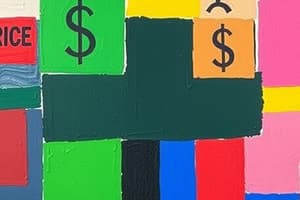Podcast
Questions and Answers
Which of the following best defines price controls?
Which of the following best defines price controls?
- Agreements between businesses to set prices artificially.
- Policies that impose legal limits on the market prices of particular goods or services. (correct)
- Subsidies provided to producers to keep prices low.
- Taxes imposed on goods with prices above a certain level.
Why might a government choose to impose price controls?
Why might a government choose to impose price controls?
- To increase tax revenue.
- To ensure market efficiency.
- To help disadvantaged groups, manage affordability, or curry favor with interest groups. (correct)
- To reduce competition and promote monopolies.
What is the primary difference between a price floor and a price ceiling?
What is the primary difference between a price floor and a price ceiling?
- A price floor sets a maximum price, while a price ceiling sets a minimum price.
- A price floor establishes a minimum price, while a price ceiling establishes a maximum price. (correct)
- A price floor benefits consumers, while a price ceiling benefits producers.
- A price floor is used for essential goods, while a price ceiling is used for luxury goods.
Which of the following is an example of a price floor?
Which of the following is an example of a price floor?
Which of the following is an example of a price ceiling?
Which of the following is an example of a price ceiling?
How does a binding price floor affect the market?
How does a binding price floor affect the market?
How does a binding price ceiling affect the market?
How does a binding price ceiling affect the market?
What is a likely consequence of a non-binding price floor?
What is a likely consequence of a non-binding price floor?
What is a likely consequence of a non-binding price ceiling?
What is a likely consequence of a non-binding price ceiling?
If a binding price floor is implemented, how might sellers try to eliminate the resulting surplus?
If a binding price floor is implemented, how might sellers try to eliminate the resulting surplus?
How might buyers cope with a shortage caused by a binding price ceiling?
How might buyers cope with a shortage caused by a binding price ceiling?
What are the likely consequences of rent control in an urban area?
What are the likely consequences of rent control in an urban area?
In the long run, how would a binding rent control policy likely affect the rental-housing shortage?
In the long run, how would a binding rent control policy likely affect the rental-housing shortage?
What is the primary objective of minimum wage laws?
What is the primary objective of minimum wage laws?
According to economic theory, what is a potential unintended consequence of minimum wage laws?
According to economic theory, what is a potential unintended consequence of minimum wage laws?
How might businesses respond to an increase in the minimum wage, besides reducing employee hours?
How might businesses respond to an increase in the minimum wage, besides reducing employee hours?
What does the 'Seattle experiment' suggest about the impact of minimum wage laws on low-skilled workers?
What does the 'Seattle experiment' suggest about the impact of minimum wage laws on low-skilled workers?
Historically, what type of price control has the U.S. government used for milk?
Historically, what type of price control has the U.S. government used for milk?
If the government buys the surplus created by a price floor on milk, what is a likely consequence?
If the government buys the surplus created by a price floor on milk, what is a likely consequence?
Which factor most determines whether a price control is 'binding'?
Which factor most determines whether a price control is 'binding'?
What is the relationship between zoning laws and price controls?
What is the relationship between zoning laws and price controls?
Consider a city where the equilibrium rent for apartments is $1500 per month. If the city imposes a rent control of $1000 per month, which of the following is most likely to occur?
Consider a city where the equilibrium rent for apartments is $1500 per month. If the city imposes a rent control of $1000 per month, which of the following is most likely to occur?
If a city implements a minimum wage that is higher than the market equilibrium wage for fast-food workers, what is the most likely short-term effect on the fast-food industry?
If a city implements a minimum wage that is higher than the market equilibrium wage for fast-food workers, what is the most likely short-term effect on the fast-food industry?
Suppose the government sets a price floor for wheat that is above the equilibrium price. To prevent a surplus, the government promises to buy any excess wheat at the price floor. What is the most likely long-term outcome?
Suppose the government sets a price floor for wheat that is above the equilibrium price. To prevent a surplus, the government promises to buy any excess wheat at the price floor. What is the most likely long-term outcome?
A law that restricts the maximum price a doctor can charge for a check-up is an example of:
A law that restricts the maximum price a doctor can charge for a check-up is an example of:
A binding price ceiling will MOST likely result in which of the effects below?
A binding price ceiling will MOST likely result in which of the effects below?
What is the most likely outcome of a minimum wage law that is set significantly ABOVE the equilibrium wage in a competitive labor market?
What is the most likely outcome of a minimum wage law that is set significantly ABOVE the equilibrium wage in a competitive labor market?
Suppose a city implements rent control that sets rental rates below market equilibrium. Which of the following is LEAST likely to occur?
Suppose a city implements rent control that sets rental rates below market equilibrium. Which of the following is LEAST likely to occur?
Flashcards
Price Controls
Price Controls
Policies that impose legal limits on the market prices of particular goods or services.
Price Floor
Price Floor
A minimum price set by the government, above which sales are legal.
Price Ceiling
Price Ceiling
A maximum price set by the government, above which sales are illegal.
Minimum Wage
Minimum Wage
Signup and view all the flashcards
Price Gouging Laws
Price Gouging Laws
Signup and view all the flashcards
Zoning
Zoning
Signup and view all the flashcards
Rent Control Consequences
Rent Control Consequences
Signup and view all the flashcards
Illegal Subletting
Illegal Subletting
Signup and view all the flashcards
Rent Control
Rent Control
Signup and view all the flashcards
Minimum Wage Impact on Prices
Minimum Wage Impact on Prices
Signup and view all the flashcards
Dairy Price Support
Dairy Price Support
Signup and view all the flashcards
Study Notes
Policy Levers: Price Controls
- Price controls involve legal limits on market prices for certain goods or services.
- Governments use price controls to aid disadvantaged groups, manage affordability, and curry favor with interest groups.
Price Floors
- A price floor establishes a minimum price.
- Prices below the set floor are illegal, which could lead to penalties.
- Agricultural price supports and minimum wage laws serve as examples of price floors.
Price Ceilings
- A price ceiling establishes a maximum price.
- Prices exceeding the ceiling are illegal, and may be subject to fines.
- Price-gouging laws and rent control are examples of price ceilings.
Binding Price Floor Scenario
- Price is set above equilibrium which affects market price and quantity.
- A binding price floor impacts total surplus in an efficient market.
Non-Binding Price Floor Scenario
- Price floor is set below the equilibrium and it does not affect market price and quantity.
- It does not affect the total surplus in the market.
Coping with a Surplus
- Sellers can eliminate surplus goods by selling on the black market at a lower price.
Binding Price Ceiling
- A binding price ceiling is set below equilibrium, impacting market price and quantity.
- Affects total surplus in an efficient market.
Non-Binding Price Ceiling
- A non-binding price ceiling is set above equilibrium price, which does not affect market price or quantity.
- Does not affect total surplus.
Coping with Shortages
- Buyers may wait or buy goods on the black market at elevated prices.
- Only those with high values would pay the black market price.
Rent Control
- Rent control aims to make housing more affordable by setting a price ceiling on rental units.
- The consequences of rent control include rental shortages and deadweight loss.
- It results in fewer available rental units due to less new construction, landlords converting units, and current tenants are likely to move less.
- Illegal subletting occurs, with units rationed based on willingness to pay rather than need.
- Black market prices often exceed regulated and free-market prices.
- Other unintended consequences include quality downgrading, "key" money, and ambulance chasing.
- Binding rent control hurts impoverished tenants due to being inefficient and poorly targeted.
Long Run Effects of Rent Controls
- A binding rent control policy increases rental-housing shortage in the long run.
Oregon Rent Control (2019)
- In periods where the unregulated price would increase by more than 7%, the number of available rental units would likely be reduces.
Minimum Wage
- Minimum wage aims to increase the living standards of the working poor.
- It functions as a price floor on the dollar-price of labor.
- The federal minimum wage is $7.25 per hour since 2009.
- Oregon's tiered minimum wage depends on the location, varying from $13.70 to $15.95 per hour as of July 1, 2024.
- Washington's minimum wage (as of January 1, 2024) is $20.76 in Seattle and $16.66 elsewhere.
- Future increases are calculated annually based on the US City average of the Consumer Price Index for All Urban Consumers.
Predictions of Minimum Wage
- Outcomes include unemployment.
- Workers who keep their jobs are better off, and those who lose jobs are likely worse off.
Evidence on Minimum Wage
- Evidence is mixed, but employment effects are often small.
- Most studies show no effect or a small negative effect on employment.
- The Seattle experiment shows negative employment effects, more evident in hours than jobs.
- Businesses increase prices in response to binding minimum wages.
- The Seattle experiment showed self-reported price increases by business owners.
- There was an observed increase in child care prices, but no change in prices or quality of supermarket food.
- There is no broad agreement on whether minimum wages improve livelihoods of low-skilled workers, but recent evidence suggests it may be possible.
- The Seattle experiment has mixed evidence, suggesting increases in wage outweigh reductions in hours, leading to small increases or no decrease in earnings.
US Dairy Price Supports
- Historically, the US government set price floors for milk.
- If the government buys the surplus of milk, this results in additional deadweight loss.
- Results in "government cheese".
Studying That Suits You
Use AI to generate personalized quizzes and flashcards to suit your learning preferences.




